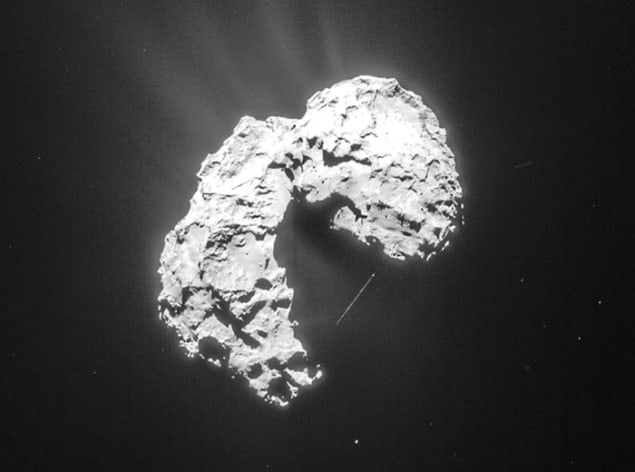
The amino acid glycine has been discovered in the comet 67P/Churyumov–Gerasimenko, suggesting that the ingredients for early life may have been delivered to Earth by comets, rather than being created on our planet. More intriguingly, it also suggests similar comets could also have delivered life elsewhere in the universe – an encouraging sign for those looking for life on other planets.
The first life on Earth is thought to have appeared around 3.7 billion years ago. However, up until 3.8 billion years ago, the Earth was too hot to retain the volatile elements needed to produce life – including water. “100 million years is a very short time to make an ocean, and then to create organic molecules in the ocean, and finally to form a living cell,” says space researcher Kathrin Altwegg of the University of Bern in Switzerland.
Scientists have suggested that the process could have been speeded up if organic molecules such as amino acids – the building blocks of proteins – had formed in one of the dark molecular clouds that give birth to stellar systems, and had been delivered to Earth ready-made by comets or meteorites. “We know that comets impacted at that time because you see it in the craters of the Moon,” explains Altwegg.
Contamination woes
In 2009 astrobiologist Jason Dworkin of NASA’s Goddard Space Flight Center in Maryland and colleagues reported that samples collected from the Wild 2 comet by NASA’s Stardust mission contained glycine. However, this was contested because the samples had to be returned to Earth for analysis, and they showed evidence of contamination. Amino acids have also been detected in meteorites, but here too it is difficult to confirm that they have extraterrestrial origins – although isotopic ratios have suggested this is the case.
In the new research, Altwegg and colleagues analysed dust from the envelope of 67P/Churyumov–Gerasimenko using the mass spectrometer ROSINA (Rosetta Orbiter Spectrometer for Ion and Neutral Analysis) onboard the European Space Agency’s Rosetta spacecraft. The spectrometer ionizes incoming molecules and continuously measures the mass-to-charge ratios of the resulting molecular fragments. The researchers found that several of these molecular fragments matched products formed by the break-up of glycine. This was surprising, say the researchers, because glycine is not very volatile, so they had not expected any glycine present in the comet to be released into the gas cloud surrounding it. Further analysis suggested that it had been attached to the dust particles in the ice.
The team found no evidence of more complex amino acids. This was expected because only glycine can form without liquid water. “It’s catalytic chemistry in the ice,” explains Altwegg. Interestingly, ROSINA also revealed phosphorus – an atom also essential for the formation of life – among the material. “The Earth has phosphorus, that’s clear – and had phosphorus all along; but if you bring the organics and the phosphorus in one ship, then it’s more likely that they react together,” Altwegg says.
“Important discovery”
“I think it’s a very important discovery using an impressive instrument and is a wonderful confirmation of the work that we demonstrated on Stardust,” says Dworkin, who was not involved in the research. He says, however, that it will “absolutely not” settle the question of the ultimate origin of life on Earth, and questions the notion that only glycine can form without liquid water. “We synthesized a number of amino acids without exposure to liquid water [in our laboratory],” he says.
I think that in the end we can show that everything you need to develop life is in a comet – just not life itself
Kathrin Altwegg, University of Bern
Planetary scientist Hal Weaver of Johns Hopkins University in the US says that, although most scientists will probably not be surprised by the confirmation that comets contain glycine, the research is “a nice affirmation of what the folks found and analysed in the Stardust samples”. “What I’d really like to do next is to bring a sample of the nucleus of a comet back to Earth so it can be analysed in detail,” he adds.
Meanwhile, Altwegg’s team continues to study the ROSINA data. “I think that, in the end, we can show that everything you need to develop life is in a comet – just not life itself,” she says. She adds that the findings have significant implications for the probability of finding extraterrestrial life. “If you form glycine and it ends up in a comet, you can imagine that it can go anywhere in the universe,” she says.
The research is described in Science Advances.



